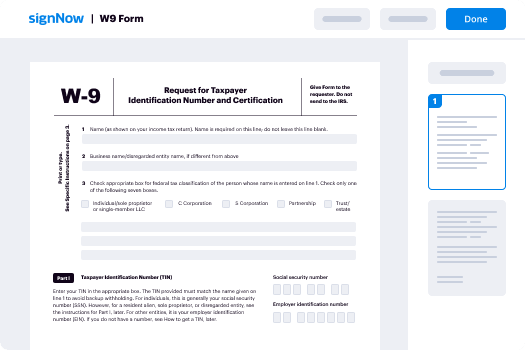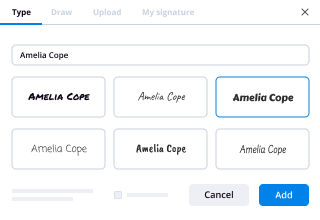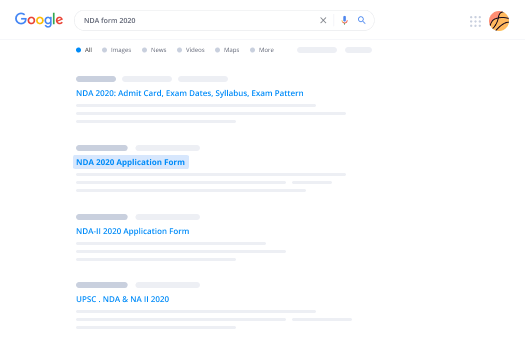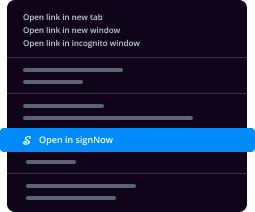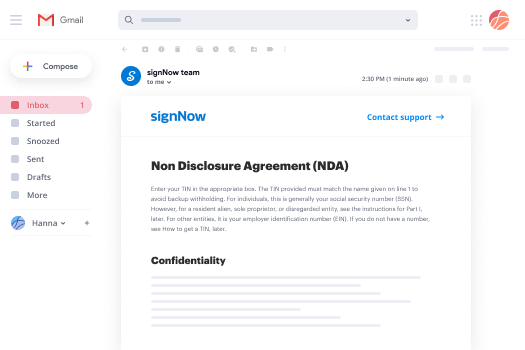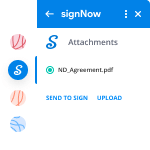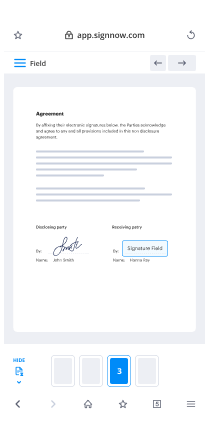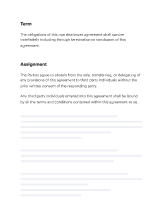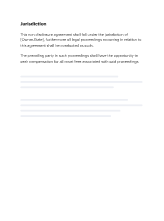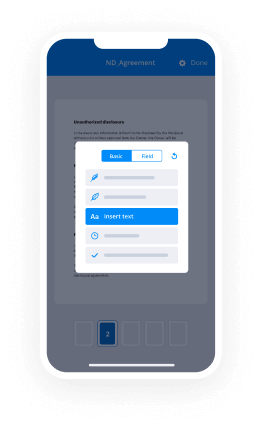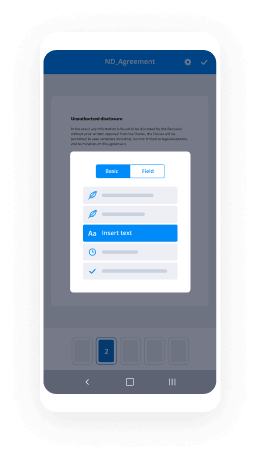Disfruta De Flujos De Trabajo De eSignature Flexibles: Qué Hace Que Un Documento Sea Legalmente Vinculante
- Rápido para iniciar
- Fácil de usar
- Soporte 24/7
Las empresas con visión de futuro de todo el mundo confían en SignNow






Guía de inicio rápido: qué hace que un documento sea legalmente vinculante
airSlate SignNow eSignature es una solución robusta para simplificar la recopilación de datos, la negociación de contratos, la cooperación externa e interna y agilizar los procesos de toma de decisiones. Firmar documentos en formato electrónico es sencillo para equipos, socios y clientes, y ayuda a su empresa a reducir el desperdicio de papel y los presupuestos innecesarios.
Complete los siguientes pasos que se enumeran a continuación y descubra qué hace que un documento sea legalmente vinculante:
- Inicie su navegador y vaya a signnow.com.
- Regístrese para una prueba gratuita o inicie sesión utilizando su correo electrónico o credenciales de Google/Facebook.
- Haga clic en Avatar de Usuario -> Mi Cuenta en la esquina superior derecha de la página web.
- Personalice su Perfil de Usuario agregando datos personales y cambiando configuraciones.
- Crear y gestionar su(s) Firma Predeterminada.
- Regrese a la página del panel de control.
- Desplace el cursor sobre el botón Subir y Crear y seleccione la opción adecuada.
- Haga clic en la tecla Preparar y Enviar junto al título del documento.
- Ingrese el nombre y la dirección de correo electrónico de todos los firmantes en el cuadro emergente que se abre.
- Utilice el menú Comenzar a agregar campos para proceder a modificar el documento y firmarlo usted mismo.
- Haga clic en GUARDAR E INVITAR cuando haya terminado.
- Continúe configurando su flujo de trabajo de eSignature utilizando funciones adicionales.
Qué hace que un documento sea legalmente vinculante es una buena pregunta y una que airSlate SignNow responde. Verifique las características que usted y su equipo necesitan para deleitar a sus clientes y compañeros en la mejor forma de hacer negocios. ¡Firme su primer contrato hoy!
Cómo funciona
Califica tu experiencia
What makes a document legally binding
A document is considered legally binding when it meets specific criteria established by law. These criteria typically include the presence of an offer, acceptance, consideration, and the intention to create a legal relationship. Additionally, both parties must have the capacity to contract and the agreement must be lawful. Understanding these elements is essential for anyone looking to create or sign a document electronically.
Key elements of a legally binding document
To ensure that a document is legally binding, it must include several key elements:
- Offer: One party must present a clear proposal to another.
- Acceptance: The other party must agree to the terms of the offer without modifications.
- Consideration: There must be something of value exchanged between the parties.
- Capacity: Both parties must have the legal ability to enter into a contract.
- Legality: The subject matter of the agreement must be legal.
Steps to complete a legally binding document electronically
Completing a legally binding document electronically involves several straightforward steps:
- Choose the document: Select the appropriate template or document type you need.
- Fill in the details: Enter the required information accurately, ensuring all parties’ names and details are correct.
- Review the document: Carefully check for any errors or missing information before proceeding.
- Request signatures: Use the eSignature feature to send the document to all parties for their signatures.
- Store securely: Once signed, save the document in a secure location for future reference.
Legal use of electronically signed documents
In the United States, electronically signed documents are generally recognized as legally binding under the Electronic Signatures in Global and National Commerce (ESIGN) Act. This law ensures that electronic signatures carry the same weight as traditional handwritten signatures, provided that both parties consent to use electronic means for signing. It is important to ensure compliance with state-specific regulations that may also apply.
Security & Compliance Guidelines
When using electronic signatures, it is crucial to adhere to security and compliance guidelines to protect sensitive information. Consider the following practices:
- Use secure platforms: Choose reputable eSignature solutions that offer encryption and secure storage.
- Authenticate signers: Implement measures to verify the identity of all parties before signing.
- Maintain records: Keep detailed logs of the signing process, including timestamps and IP addresses.
- Stay informed: Regularly review compliance with applicable laws and regulations regarding electronic signatures.
Examples of using legally binding documents
Legally binding documents can be used in various scenarios, including:
- Contracts: Agreements between businesses or individuals for services or goods.
- Leases: Rental agreements between landlords and tenants.
- Employment agreements: Contracts outlining the terms of employment between an employer and employee.
- Non-disclosure agreements (NDAs): Contracts protecting confidential information shared between parties.
¡Obtenga ahora firmas vinculantes desde el punto de vista jurídico!
-
Mejor ROI. Nuestros clientes logran un promedio de 7x ROI en los primeros seis meses.
-
Se adapta a sus casos de uso. De las PYMES al mercado medio, airSlate SignNow ofrece resultados para empresas de todos los tamaños.
-
Interfaz de usuario intuitiva y API. Firma y envía documentos desde tus aplicaciones en minutos.
Firma en línea FAQs
-
What makes a document legally binding in the context of eSignatures?
A document is considered legally binding when it meets certain criteria, including the intent to create a legal obligation, mutual consent, and the presence of a signature. With airSlate SignNow, electronic signatures are recognized as valid under the ESIGN Act and UETA, ensuring that what makes a document legally binding is upheld in digital transactions. -
How does airSlate SignNow ensure the legality of eSigned documents?
airSlate SignNow employs advanced security measures and complies with legal standards to ensure that eSigned documents are legally binding. This includes features like audit trails, timestamps, and secure storage, which all contribute to what makes a document legally binding in the eyes of the law. -
What features does airSlate SignNow offer to enhance document legality?
airSlate SignNow offers features such as customizable templates, in-person signing, and multi-party signing, all of which enhance the legality of your documents. These features ensure that all parties involved understand and agree to the terms, which is crucial for what makes a document legally binding. -
Is there a cost associated with using airSlate SignNow for legally binding documents?
Yes, airSlate SignNow offers various pricing plans that cater to different business needs. Each plan provides access to features that ensure your documents meet the criteria of what makes a document legally binding, making it a cost-effective solution for businesses. -
Can I integrate airSlate SignNow with other applications?
Absolutely! airSlate SignNow integrates seamlessly with various applications such as Google Drive, Salesforce, and Microsoft Office. This integration enhances workflow efficiency and ensures that all documents processed through these platforms are compliant with what makes a document legally binding. -
What are the benefits of using airSlate SignNow for eSigning?
Using airSlate SignNow for eSigning offers numerous benefits, including increased efficiency, reduced paper usage, and enhanced security. These advantages contribute to what makes a document legally binding, as they streamline the signing process while ensuring compliance with legal standards. -
How does airSlate SignNow handle document security?
airSlate SignNow prioritizes document security by employing encryption, secure access controls, and regular audits. This commitment to security is essential for what makes a document legally binding, as it protects sensitive information and ensures the integrity of the signed documents.




















